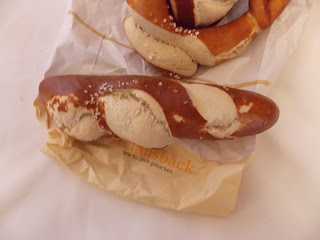Brezels.......the snack food of Germany
In Heidelberg as a guest of Heidelberg Marketing, I had the pleasure of spending a day with expat Charlotte Frey. As we toured the old town to discover solo friendly activities and restaurants she shared many unique, historic facts about Heidelberg.
 |
| Brezels are sold everywhere |
Pretzels are a staple on air flights, pretzels are offered in bars and large, 'soft' pretzels are found in food courts and at festivals and fairs.
Brezels in Germany have a long history and are ever present in daily life in Heidelberg. As we walked around the Cathedral where vendors may have had the same stalls for hundreds of years, Ms Frey showed me carvings in the stone that resemble pretzels.
In Germany these are BREZELS and have an economic history as well as a gastronomic one.
The carvings denoted the size standard of the brezel that was to be sold.
Some of the carvings were much smaller than others. When the harvest was poor the standardize brezel size was smaller!
Bezels are German snack food. You always have bread with beer. There is no fat in a Brezel or preservatives. Charlotte told me "I can't imagine life without a bretzel"!
Thanks to the great resources online, you find a great history on pretzels!
Here are a few facts about German brezels:
There is a religious connection to the history of the bretze:
"Pretzels have long been integrated into the Christian faith. By the 16th century, it had become tradition to eat pretzels on Good Friday in Germany, and Catholics once considered them the “official food of lent.” Earlier laws of the Church stated that only one meal a day was to be eaten during lent and the food couldn’t come from an animal."
Pretzels are put into a lye or baking powder solution!
"Before baking, the formed pretzel is dunked briefly in a mixture of sodium hydroxide and water. In German this mixture is called Natronlauge. This is what gives the pretzel its unique color and flavor. Because of this technique, this type of pretzel is also called a Laugenbrezel."http://germanfoodguide.com/pretzel.cfm
"Pretzels today continue to be formed by hand as has been done throughout history. Bakers spend years perfecting the pretzel-forming technique. First, the dough needs to be rolled out. Both ends of the strand are held up, and through a quick swing, the center of the strand is twisted. The ends are then pressed onto the body of the pretzel" http://germanfoodguide.co
m/pretzel.cfm
250 year old Brezel found in in Regensburg
"Carbon dating showed the pastries were made between 1700 and 1800. Indeed, the archaeologists found written evidence that in 1753 a baker named Johann Georg Held was living at the site."
http://news.discovery.com/history/archaeology/worlds-oldest-pretzel-found-in-germany-150313.htm
The most popular pretzel is the so called Laugenbretzel. It consists out of
flour, malt, salt, yeast and water.
Before baking, the formed pretzel is
dunked briefly (just some seconds) in a mixture of sodium hydroxide and water
(ph 13-14). It helps to bring about the brown color that will occur during the
baking process. In German this mixture is called Natronlauge
http://mybestgermanrecipes.com/german-pretzels/
What other snack foods are popular in other countries?
Next we visited the oldest chocolate store!
Historic Highlights of Germany:off the beaten path, made my tour of 8 German cities possible. The opinions are my own.









No comments:
Post a Comment